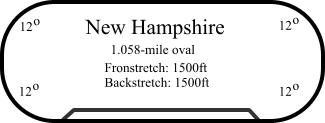

New Hampshire International Speedway: The Magic Mile
RACES:6/29/08 Race 17 Lenox Industrial Tools 300 1:45 p.m. TNT9/14/08 Race 27 Sylvania 300 1:10 p.m. ABCThe New Hampshire International Speedway has been called one of the most unusual tracks on the NASCAR Circuit. Some have even claimed it is Martinsville Speedway on drugs. The Speedway is a 1.058 mile oval track that has been having NASCAR races since July of 1990. When the track opened June of 1990 after nine long months of construction, it was redesigned into a Multi-Purpose track. There are other types of races held at this track, such as the Loudon Classic Motorcycle Races, the WKA Go-Kart races, and the SCCA Races. It held the Title for being the largest track in New England and now is the largest of any of the Sports Circuit. In the July 1990 the first Nationwide Series race was held there. Due to the Busch races becoming so popular in the following three years, the NASCAR Cup Series came to New Hampshire International Speedway in 1993 and Rusty Wallace won the first race, it was the inaugural Slick 50 300 In 2004 the speedway became the first race in the NASCAR Chase for the Cup. The track has had some bad history as well, on July 7, 2000 Kenny Irwin was the second driver to die in a crash at the track during Cup practice only two months after Adam Petty died in a crash during Nationwide Series practice on May 12, 2000. But in true NASCAR fashion turning tragedy into triumph, the Petty family opened Victory Junction Gang Camp in honor of Adam. Due to these unfortunate accidents, NASCAR decided to run restrictor plates on all of the cars. It was the first track in history besides Daytona and Talladega to use the plates. However, when Jeff Burton won the next race in an uneventful contest with no lead changes, they went back to the original form of racing. A wreck at New Hampshire was also the reason for NASCAR to change from racing back to the caution flag to the free pass system. Dale Jarrett spun his car in turn 4 and was sitting sideways on the racetrack while other cars raced backed to the start/finish line putting Jarrett in danger. Drivers who were one or more laps down did this to potentially get a lap back. NASCAR decided to ban racing back to the start finish line when a caution came out and automatically give the first car 1-lap down a free pass back onto the lead lap. The driver who gets the free pass is sometimes referred to as 'The Lucky Dog'. In 2002, the track changed its shape to create more intense banking, and the apron became a paved part of the track. The track is basically flat with 12 degree banking in the turns. The New Hampshire International Speedway is not only 1.058 mile oval speedway with 12 degree turns, it is also a 1.6 mile 12 turn road course. There are 91,000 seats, 38 VIP suites, 2 ticket booths, 4 elevators and 26 Concession stands. The New Hampshire International Speedway is one of the most gripping fan thrilling tracks on the NASCAR Circuit.
Return from New Hampshire International Speedway to Speedway Guide
|
































